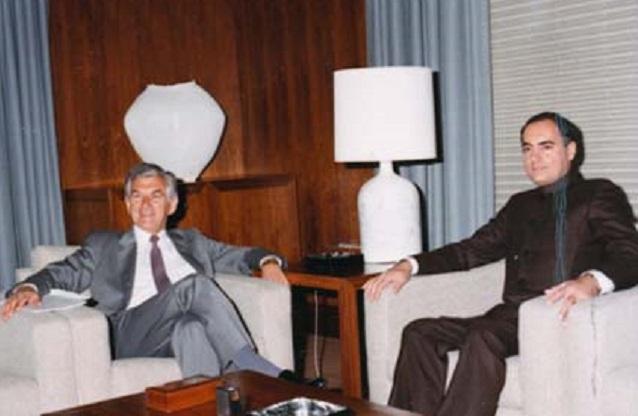Oz–India: interests not just leaders
Posted By Graeme Dobell on September 7, 2015 @ 06:00
The differences between Australia and India will be bridged by systemic needs and policy problems, not by leadership will.
Instead of leadership chemistry, the drivers can be the convergence of strategic interests and the great strengthening of economic ties—plus the growing Indian diaspora in Australia.
The previous column [2] noted how personal chemistry between leaders repeatedly failed to bring Australia and India together. The habits of mind of the bureaucracies in Canberra and New Delhi easily outlasted temporary prime ministerial enthusiasms.
The old chemistry magic got a rerun last year when Narendra Modi visited Oz. It was 28 years since the previous visit by an Indian PM (Rajiv Gandhi), so Tony Abbott was entitled to gush. Granted, Modi mainly came for the G20 in Brisbane, but the bilateral visit that followed was, indeed, gush-worthy.
Take it away [3], Tony:
‘India, as we know, is one of the world’s emerging super powers. India, I often say, is the emerging democratic super power of Asia.’
And then there’s that personal chemistry. Here’s Tony in gush mode [4]:
‘I regard Prime Minister Modi as more than a kindred spirit, as almost a brother.’
Well, political brothers and perhaps diplomatic companions. Nothing wrong with a bit of mutual affection between top politicians from different places; the job of leaders is to tell good stories at home and abroad. The Oz–India transformation, though, won’t be done by leader chemistry or the will of two PMs.
My series of columns on Australia–India relations is working towards what is always a dangerous conclusion in international or personal relationships: this time it’s different! This time Australia and India don’t have to rely on the old standards—cricket, Commonwealth and leadership chemistry—to construct a story of shared interests and close-to-common purposes.
Abbott has a script on hand from his mentor, John Howard. As Australia’s second longest serving Prime Minister notes [5], Canberra is starting to feel the tensions in the ‘great duality’ of its dealings with China and the US.
In his memoirs [6], Howard makes some big bets against China in favour of both India and the US.
Howard offers the sort of long view that comes more comfortably to a leader no longer doing the daily business:
‘Being the largest democracy in the world, India does not face a Chinese-style denouement. By the end of this century, India could well be more powerful economically and politically than China.’
Australia and India have a chance to navigate with some favourable [7] currents [8].
The meeting of minds between Modi and Abbott is of two political pros who see the potential for a lot of mutually beneficial business—both strategic and economic. The emotional content in the Modi visit to Oz was in his meeting with Indians living in Australia. Reaching out to the Indian diaspora—rally functioning as celebration—Modi offered a strikingly different marker for what India and Australia can aspire to, based on people, not just policy.
A big mutual policy agenda marks the rise in temperature between Australia and India. And there’s now the chance for some leadership chemistry that builds on a substantial economic and security agenda; the leaders don’t have to create the sense of opportunity and aspiration.
Previous generations of leaders met once every two years at the Commonwealth summit. The Commonwealth framed interactions between Australia and India, often in a comfortable rather than dynamic fashion—plus the Commonwealth policy challenge tended to be Africa, not Asia. Little wonder that cricket was ever the dominant metaphor.
These days, the leaders of Australia and India will get together at least twice a year, at the East Asia Summit and the G20. As Modi observed in Canberra last year:
‘Prime Minister Abbott and I have spent the last week together; at the East Asia summit, the G20 and for this bilateral summit. This reflects the broad framework of our relationship defined by our growing partnership in the cause of a peaceful and prosperous world and a strong and broad-based bilateral relationship.’
The multilateral framework can be used to enhance and drive bilateral ambitions—and even warm the personal chemistry.
Article printed from The Strategist: https://aspistrategist.ru
URL to article: /oz-india-interests-not-just-leaders/
URLs in this post:
[1] Image: https://aspistrategist.ru/wp-content/uploads/2015/09/ShowImage-6.jpg
[2] previous column: https://aspistrategist.ru/oz-india-commonwealth-to-chemistry/
[3] Take it away: https://www.pm.gov.au/media/2014-11-18/joint-press-statement-prime-minister-modi-canberra
[4] gush mode: http://www.abc.net.au/lateline/content/2014/s4131444.htm
[5] notes: http://www.lowyinterpreter.org/post/2010/11/19/China-and-the-Great-Asia-Project-III-Four-bets-on-China-to-lose.aspx
[6] memoirs: http://www.harpercollins.com.au/9781460702505/lazarus-rising-revised-edition
[7] favourable: https://aspistrategist.ru/australia-india-and-strategic-convergence/
[8] currents: https://aspistrategist.ru/india-and-the-indo-pacific-2/
Click here to print.
